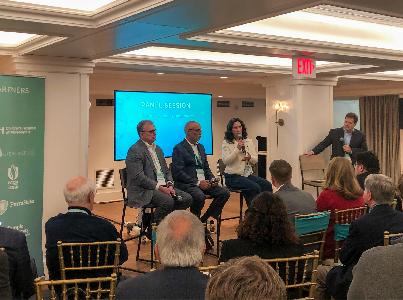
This is How I Got Here, a series where we chart the career journeys of technologists. Want to tell your story? Get in touch.
When Strawberry Mansion native and West Philly resident Samirah Devaughn-Marshall started their studies focusing on English at the Community College of Philadelphia, they were intent on a career as a music writer. They quickly ran into difficulties trying to secure internships, and decided to do things their way instead.
“My trajectory started when I wanted to create a website for myself,” they told Technical.ly. “I found a joy in creating a website as much as I did writing for the website. My heart leaned more toward making the website the experience.”
With a newfound love for user experience and user interface design, they left CCP after they learned they could get certificates in those skills as alternatives to earning college degrees. Moreover, they found that experience in doing the work has a higher value than learning the theory behind it in a classroom.
“Going to school helps, but nothing compares to doing it on your own,” they said. “People from Google don’t just care about your schooling. That’s how I get most of my jobs. Without a master’s degree, I still make successful things happen. The key to tech is not being the smartest but being willing to grow.”
UX/UI work is an integral part of all the products that we see and use on a daily basis, Devaughn-Marshall said. They frequently sketch their ideas of what an interface for a website should look like and later creates with those sketches as a guide.
Devaughn-Marshall now works as a creative assistant for a mid-Atlantic transaction management company. Their work combines marketing tasks with tech responsibilities like making sure the company site’s backend is functioning correctly and looks aesthetically pleasing on the front end, as well as creating templates to increase engagement for the brand’s social media. Adobe Photoshop, Illustrator and Dreamweaver are integral parts of their toolkit. What they enjoy most about their role is the ability to build their muscle as a designer while acclimating to the office experience of a 9-to-5 employee.
Meanwhile, a specialization in color theory helps fuel much of Devaughn-Marshall’s independent work, including passion projects such as designing color palettes derived from the album cover art of musicians like Alabama rapper Flo Milli.
Here’s my color palette for @_FloMilli’s new album. I put a little more effort in this one. 🖤 pic.twitter.com/G0yk91BSDH
— S. 🧩 (@MilkMuva) July 25, 2020
“[It’s] how colors interact with each other and how it makes your brain feel,” they said. “It’s why you buy something. Something as simple as that will prime you to think of the brand you interact with. That’s how I present my skills. I usually work with startup brands that are trying to develop what they want to look like. That’s UI. The boldness behind Nike’s [orange] is what makes it so iconic. Anything that is bright and loud will prime your brain.”
Not being afraid to make mistakes and remaining open-minded is a skill Devaughn-Marshall believes any UX/UI professional should have. They used to dread writing a page of code only for one line to make it all dysfunctional. Over time, they learned that they could quickly fix small errors and still have their work intact.
“You can always go back in code and erase it,” they said. “It’s a quick analogy to remember with tech. It’s really about not fearing mistakes. It’s about not fearing taking a page out of somebody else’s book.”
Devaughn-Marshall is also a chronic arthritis patient and has been on watch for lupus for the past two years. Living with a chronic illness has emboldened their zeal for the work they do in UX/UI.
“Having this disease and pursuing my career gives the representation I wish I had [growing up] that you can be ‘sick’ and still have the life you want,” they said. “I once feared being on SSI or disability. It’s all about going for it.”
Now 26, Devaughn-Marshall has learned so much about design and tech careers since they were a 19-year-old music writer finding their path in college. They consider themself fortunate to be in their current professional space — and remembers that the days of thinking they would still be getting a tech degree by this point are long gone.
Michael Butler is a 2020-2022 corps member for Report for America, an initiative of The Groundtruth Project that pairs young journalists with local newsrooms. This position is supported by the Lenfest Institute for Journalism.Join the conversation!
Find news, events, jobs and people who share your interests on Technical.ly's open community Slack

Philly daily roundup: Women's health startup wins pitch; $204M for internet access; 'GamingWalls' for sports venues

Philly daily roundup: East Market coworking; Temple's $2.5M engineering donation; WITS spring summit

Philly daily roundup: Jason Bannon leaves Ben Franklin; $26M for narcolepsy treatment; Philly Tech Calendar turns one


